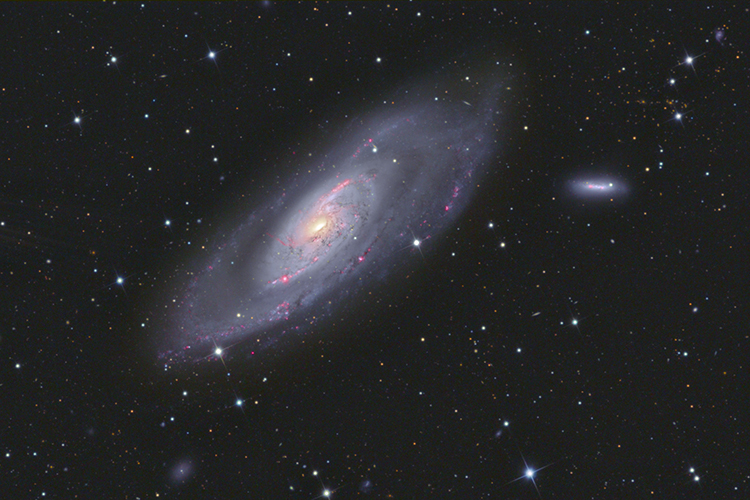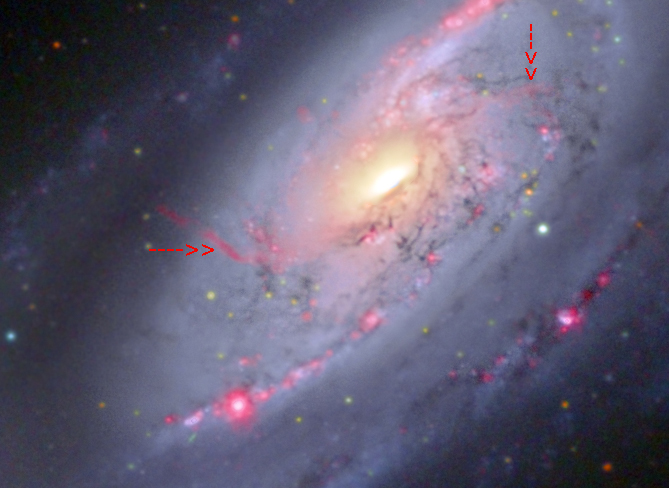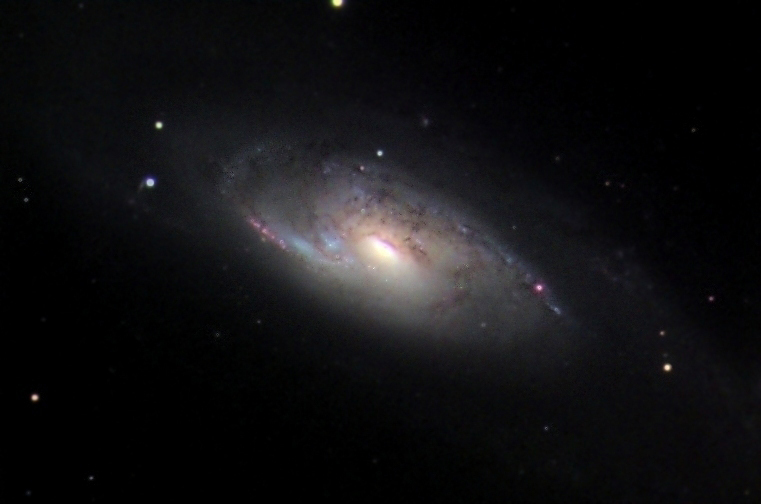|
|
Click the image for a 55%
size, 1.16 arcsec/pixel display (1800 X 1200)
Place your
mouse over the image to see the secondary set of spiral
arms)
|
Credit: |
X-ray: NASA/CXC/Univ.
of Maryland/A.S. Wilson et al.; |
|
Optical: Pal.Obs. DSS; IR: NASA/JPL-Caltech; VLA: NRAO/AUI/NSF) |
|
Instrument |
12.5" RCOS @
~f/9 (2880 mm fl) 0.643 arcsec / pixel. Shown resampled to
2.78
arcsec / pixel. |
|
Mount |
Paramount ME |
|
Camera |
SBIG STL-11000 w/
internal filter wheel, AstroDon G1 Filters |
|
Acquisition Data |
4/01/2009 to 5/13/2009
Chino Valley, AZ |
|
Exposure |
Lum
405 min (27 x 15 min, bin 1x1)
RGB
405 min ( 9 x 15 min each, bin 1x1)
Ha
900 min (30 x 30 min each, bin 1x1)
L(HaR)GB image with an
LRGB overlay for star colors. The Ha data was combined with
the Red using the lighten blend mode with 50% obacity. It was
not necessary to add the Ha to the luminance. |
|
Software |
CCDSoft,
CCDStack, Photoshop CS w/ the Fits Liberator plugin,
Noel
Carboni's actions and Russ Croman's Gradient Exterminator
CCDStack to register,
normalize, data reject, combine and luminance sharpen.
PhotoShop for the
color combine. |
|
Comment |
North is ~ to the top... the image is rotated 21 Deg's to the right.
Discovered by Pierre
Méchain, in 1781, Messier 106 (also known as NGC 4258) is a spiral
galaxy in the constellation Canes Venatici. M106 is at a distance of
about 23 million light-years from Earth. It is also a Seyfert
II galaxy, which means that due to x-rays and unusual emission lines
detected, it is suspected that part of the galaxy is falling into a
supermassive black hole in the center.
NGC 4248, to the right,
at a distance of about 21 million light-years is a
possible companion galaxy.
The second image shows
a seldom imaged hydrogen gas jet, at the lower left of the galaxy
core. It has only recently been
determined that this is actually part of a secondary set of spiral arms,
indicated by the arrows. This was revealed by University of Maryland
astronomers, led by Yuxuan Yang, by combining images from
NASA's Chandra X-ray Observatory, NASA's Spitzer Space Telescope,
the European Space Agency's XMM-Newton X-ray observatory, and data
obtained almost a decade ago with NASA's Hubble Space Telescope.
Place your mouse pointer over the second image to see the arms.
|
════════════════════════════════════════
|
Instrument |
Celestron C11 @ F6.1 (1705
mm) 1.087 arcsec / pixel |
|
Mount |
Losmandy G11 |
|
Camera |
SBIG ST-7 with CFW-8A color wheel |
|
Acquisition Date |
4/21/06 to 4/23/06
Near downtown Seattle |
|
Exposure |
Lum
285 min (19 x 15 min)
Red 60 min (4 x 15 min)
Green 60 min (4 x 15 min)
Blue 66 min (3 x 22 min) |
|
Software |
CCDSoft, CCDOPS,
Sigma Clip (pre beta 11), PhotoShop CS and Paint Shop Pro. |
|
Comment |
North is to the left. |
|



